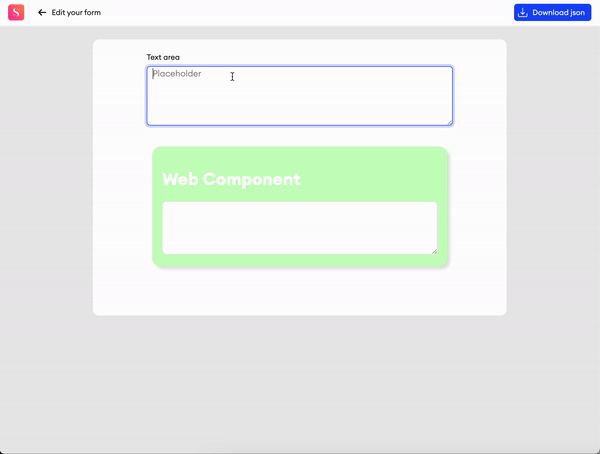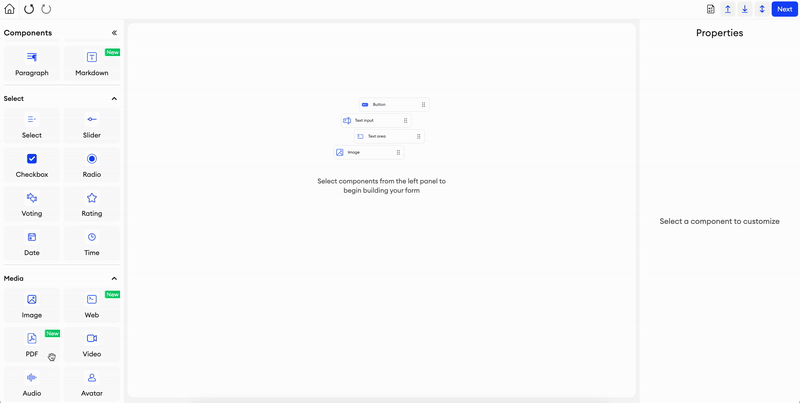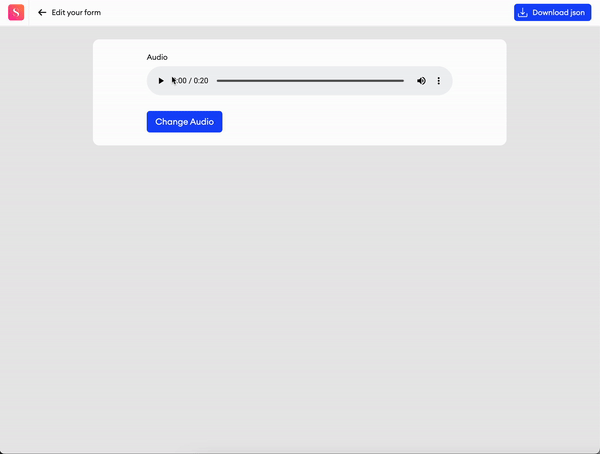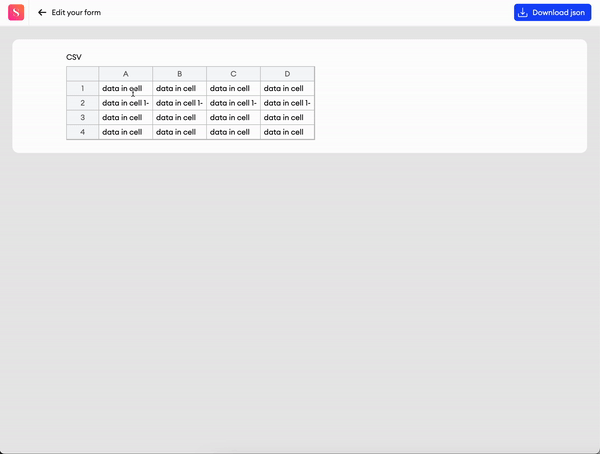Media
Image
This is an image component. It displays any image, whether you provide the source for it or if the user uploads one.
There are a couple of ways you can alter how you view your image:
- You can click on the image either in the form preview or in the editor to view it up close. Viewing the image in this way, you can zoom in for a closer inspection, and even rotate the image.
- You can click on the settings in the top right corner of the component to adjust the brightness and contrast of the image (min -100%, max 100%).
Parameters
Label- Text input indicating the label of the component visible in the UI.Add info icon- Disabled by default. When enabled, it shows a tooltip icon on the component. The tooltip shows text that can be entered in the component’s properties.Source URL- A source URL of the image.Alt text- Alternative text.Width- The default width of the component.Height- The default height of the component.Fill image- An option to fill the image within the component.Fit image- An option to fit the image within the component.Exclude from annotation JSON- If checked, this component and its values will be excluded from the item’s annotation JSON. You also won’t be able to upload data for it.
Related Functions
getValue(path: List[Union[str, int]])- Returns the url of the image component.setValue(path: List[Union[str, int]], value: str)- Sets the url of the image component.

Web
With this component, you can use custom code to display a webpage in the form.
Parameters
Add info icon- Disabled by default. When enabled, it shows a tooltip icon on the component. The tooltip shows text that can be entered in the component’s properties.+ Set keys- Under Values, you can set up to 10 key-value pairs for the values of the Web component, which can then be queried in Explore using the component’s ID. For this, you must provide a key name and a value type (String, Number, Timestamp). You may also select whether or not this key is an array. These keys can be edited at any time. The value types are as follows:- String - the value must be a string input.
- Number - the value must be numeric.
- Timestamp - the value must be in ISO 8601 formatting.
Code- By editing the component directly from the canvas, you can write your web code. You can then click Save to see what it'll look like before creating the form.Width- The default width of the component.Height- The default height of the component.Exclude from export- Checkbox. Enabled by default. When enabled, the value of the component will be excluded from the exported annotation JSON.
Related Functions
getValue(path: List[Union[str, int]])- Returns the value of the component’s code.setValue(path: List[Union[str, int]], value: str)- Sets the value of the component’s code.postMessageToWebComponent(path: List[Union[str, int]], message: Union[str, dict])- Sends themessagestring to the web component.getItemStatus()- Returns the status name of the currently opened item.getUserRole()- Returns the role name of the user who currently has the item open.
Related Events
on_<component id>_message(path: List[Union[str, int]], value: Union[str, dict]):- Fired when there is a message from the web component, receives the component's path and the value of the incoming message.
Sending messages from web component
window.parent.postMessage({ action: 'topy', data }, "*");- Use this JavaScript function to send a message to the main editor. Usetopyas an action identifier.

PDF
This component allows you to import a PDF file and view it in the form.
Parameters
Label- Text input indicating the label of the component visible in the UI.Add info icon- Disabled by default. When enabled, it shows a tooltip icon on the component. The tooltip shows text that can be entered in the component’s properties.Source URL- A source URL of the pdf.Height- Numeric input that defines the height of the web component.Width- The default width of the component.Height- The default height of the component.Exclude from export- Checkbox. Disabled by default. When enabled, the value of the component will be excluded from the exported annotation JSON.
Related Functions
getValue(path: List[Union[str, int]])- Returns the url of the PDF component.setValue(path: List[Union[str, int]], value: str)- Sets the url of the PDF component.

URL
With this component, you can provide a source URL to display a webpage in the form.
Parameters
Add info icon- Disabled by default. When enabled, it shows a tooltip icon on the component. The tooltip shows text that can be entered in the component’s properties.URL- You can provide the url of the webpage you want displayed on this component.Height- Numeric input that defines the height of the web component.Exclude from export- Checkbox. Enabled by default. When enabled, the value of the component will be excluded from the exported annotation JSON.
Related Functions
getValue(path: List[Union[str, int]])- Returns the value of the component’s code.setValue(path: List[Union[str, int]], value: str)- Sets the value of the component’s code.
Video
This is a video component. It displays any video, whether you provide the source for it or if the user uploads one.
Parameters
Label- Text input indicating the label of the component visible in the UI.Add info icon- Disabled by default. When enabled, it shows a tooltip icon on the component. The tooltip shows text that can be entered in the component’s properties.Source URL- A source URL of the video.Width- The default width of the component.Height- The default height of the component.Exclude from export- Checkbox. Disabled by default. When enabled, the value of the component will be excluded from the exported annotation JSON.
Related Functions
getValue(path: List[Union[str, int]])- Returns the url of the video component.setValue(path: List[Union[str, int]], value: str)- Sets the url of the video component.

Audio
This is an audio component. It displays any audio clip, whether you provide the source for it or if the user uploads one.
Parameters
Label- Text input indicating the label of the component visible in the UI.Add info icon- Disabled by default. When enabled, it shows a tooltip icon on the component. The tooltip shows text that can be entered in the component’s properties.Source URL- A source URL of the audio.Width- The default width of the component.Exclude from export- Checkbox. Disabled by default. When enabled, the value of the component will be excluded from the exported annotation JSON.
Related Functions
getValue(path: List[Union[str, int]])- Returns the url of the audio component.setValue(path: List[Union[str, int]], value: str)- Sets the url of the audio component.

Avatar
This component is an avatar icon display. It displays an avatar image, whether you provide the source for it or if the user uploads one.
Parameters
Label- Text input indicating the label of the component visible in the UI.Add info icon- Disabled by default. When enabled, it shows a tooltip icon on the component. The tooltip shows text that can be entered in the component’s properties.Source URL- A source URL of the avatar image.Alt text- Alternative text.Exclude from export- Checkbox. Disabled by default. When enabled, the value of the component will be excluded from the exported annotation JSON.
Related Functions
getValue(path: List[Union[str, int]])- Returns the url of the avatar component.setValue(path: List[Union[str, int]], value: str)- Sets the url of the avatar component.
CSV
This component allows you to display editable CSV grids in your forms.
Parameters:
Label- Text input indicating the label of the component visible on the UI.Add info icon- Disabled by default. When enabled, it shows a tooltip icon on the component. The tooltip shows text that can be entered in the component’s properties.Value- Text input field where the CSV data can be filled. The delimiter can be used to divide the data into columns.Delimiter- This is where you can select what symbol to use to divide your data into columns.Exclude from export- Checkbox. Disabled by default. When enabled, the value of the component will be excluded from the exported annotation JSON.
Related Functions
-
getValue(path: List[Union[str, int]])- Returns the data of the component. -
setValue(path: List[Union[str, int]], value: str)- Sets the data of the component. -
disable(path: List[Union[str, int]])- Disables the component. -
enable(path: List[Union[str, int]])- Enables the component.
Related Events
on_<component id>_change(path: List[Union[str, int]], value: str):- Fired when there is a change in the component's CSV data, receives the component's path and the CSV content.

Updated 13 days ago